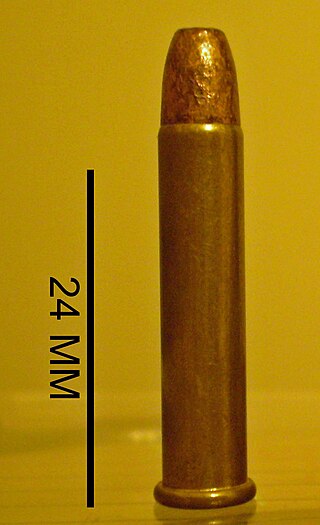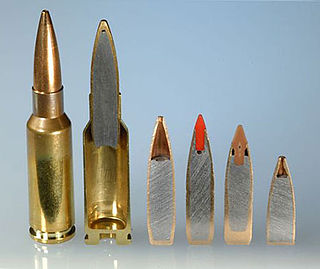The 7.62 mm caliber is a nominal caliber used for a number of different cartridges. Historically, this class of cartridge was commonly known as .30 caliber, the equivalent in Imperial and United States Customary measures. It is most commonly used in hunting cartridges. The measurement equals 0.30 inches or three decimal lines, written .3″ and read as three-line.

A cartridge, also known as a round, is a type of pre-assembled firearm ammunition packaging a projectile, a propellant substance and an ignition device (primer) within a metallic, paper, or plastic case that is precisely made to fit within the barrel chamber of a breechloading gun, for convenient transportation and handling during shooting. Although in popular usage the term "bullet" is often used to refer to a complete cartridge, the correct usage only refers to the projectile.

The .45 Colt (11.43×33mmR), is a rimmed, straight-walled, handgun cartridge dating to 1872. It was originally a black-powder revolver round developed for the Colt Single Action Army revolver. This cartridge was adopted by the U.S. Army in 1873 and served as an official US military handgun cartridge for 19 years, before being replaced by the .38 Long Colt in 1892.

The .44 Remington Magnum, also known as .44 Magnum or 10.9x33mmR, is a rimmed, large-bore cartridge originally designed for revolvers and quickly adopted for carbines and rifles. Despite the ".44" designation, guns chambered for the .44 Magnum round, its parent case, the .44 Special, and its parent case, the .44 Russian all use 0.429 in (10.9 mm) diameter bullets. The .44 Magnum is based on the .44 Special case but lengthened and loaded to higher pressures for greater velocity and energy.

The .44 Smith & Wesson Special, also commonly known as .44 S&W Special, .44 Special, .44 Spl, .44 Spc, or 10.9×29mmR, is a smokeless powder center fire metallic revolver cartridge developed by Smith & Wesson in 1907 as the standard chambering for their New Century revolver, introduced in 1908.

The .22 Winchester Magnum Rimfire, also known as the .22 WMR, .22 Magnum, .22 WMRF, .22 MRF, or .22 Mag, is a rimfire cartridge. Originally loaded with a bullet weight of 40 grains (2.6 g) delivering velocities in the 2,000 feet per second (610 m/s) range from a rifle barrel, .22 WMR is now loaded with bullet weights ranging from 50 grains (3.2 g) at 1,530 feet per second (470 m/s) to 30 grains (1.9 g) at 2,200 feet per second (670 m/s).

A wildcat cartridge, often shortened to wildcat, is a custom cartridge for which ammunition and/or firearms are not mass-produced. These cartridges are often created in order to optimize a certain performance characteristic of an existing commercial cartridge, or may merely be intended as novelty items.

The Jericho 941 is a double-action/single-action semi-automatic pistol developed by Israel Weapon Industries that was introduced in 1990.
A rim is an external flange that is machined, cast, molded, stamped, or pressed around the bottom of a firearms cartridge. Thus, rimmed cartridges are sometimes called "flanged" cartridges. Almost all cartridges feature an extractor or headspacing rim, in spite of the fact that some cartridges are known as "rimless cartridges". The rim may serve a number of purposes, including providing a lip for the extractor to engage, and sometimes serving to headspace the cartridge.
The .376 Steyr (9.5x59mmRB) cartridge is a rebated rim rifle cartridge jointly developed by Hornady and Steyr for use in the Steyr Scout rifle.

The 6.5mm Grendel is an intermediate cartridge jointly designed by British-American armorer Bill Alexander, competitive shooter Arne Brennan and Lapua ballistician Janne Pohjoispää, as a low-recoil, high-precision rifle cartridge specifically for the AR-15 platform at medium/long range. It is an improved variation of the 6.5mm PPC.

The Magnum Research BFR is a single-action revolver manufactured by Magnum Research. Modeled after the Ruger Blackhawk, it is constructed of stainless steel and chambered for a number of powerful handgun cartridges, such as .460 S&W Magnum and .500 S&W Magnum; popular rifle chamberings, including .30–30 WCF, .444 Marlin, and .45-70 Government; and even .410 bore shotshells. Notably, the BFR platform has also served as the basis for custom caliber conversions to 19th century big game cartridges such as the .50–110 WCF and .50-90 Sharps, as well as the .500 Bushwhacker, which is currently considered to be the most powerful handgun cartridge in the world in terms of muzzle energy. The name "BFR" originally stood for "Brainerd’s First Revolver", in reference to Brainerd, Minnesota, where the early BFRs were manufactured. Officially the acronym now stands for "Biggest, Finest Revolver", though it was rebranded for a time as the "Big Frame Revolver" after Magnum Research's 2010 acquisition by Kahr Arms. It is sometimes referred to as the "Big Fucking Revolver", but this is a misnomer often used for humorous effect and has never been officially sanctioned by manufacturers.

The .458 SOCOM (11.63×40mmRB) is a moderately large round designed to work in an AR-15 platform. This is achieved by installing a 458 bolt and barrel. The 300-grain (19 g) round offers a supersonic muzzle velocity of 1,900 ft/s (580 m/s) and 2,405 ft⋅lbf (3,261 J), similar to a light .45-70 but with a much smaller case.

.22 caliber, or 5.6 mm, refers to a common firearms bore diameter of 0.22 inch (5.6 mm) in both rimfire and centerfire cartridges.

The .450 Bushmaster (11.48x43mmRB) is a rifle cartridge developed by Tim LeGendre of LeMag Firearms, and licensed to Bushmaster Firearms International. The .450 Bushmaster is designed to be used in standard M16s and AR-15s, using modified magazines and upper receiver assemblies.

The .500 Linebaugh is a .50 caliber handgun cartridge designed for use in revolvers. It is considered one of the most powerful handgun cartridges designed in terms of kinetic energy and power factor (momentum).
The .500 S&W Magnum or 12.7×41mmSR is a .50 caliber semi-rimmed revolver cartridge developed by Cor-Bon in partnership with the Smith & Wesson "X-Gun" engineering team for use in the Smith & Wesson Model 500 X-frame revolver and introduced in February 2003 at the SHOT Show. From its inception, it was intended to be the most powerful handgun cartridge to date, with the capacity to harvest all North American game species. While more powerful handgun cartridges, such as the .500 Bushwhacker, have emerged since, they are only available in custom firearms, and the .500 S&W remains the most powerful production handgun cartridge.
The .375 SOCOM (9.5x40mmRB) round is a custom developed round created by Tony Rumore of Tromix Lead Delivery Systems. Cases are formed from .458 SOCOM run through a custom .375 SOCOM sizing die.
Nosler produces six different rebated rim hunting cartridges. The first to be introduced was .26 Nosler, followed by .28 Nosler, .30 Nosler, .33 Nosler, .22 Nosler, and .27 Nosler.














